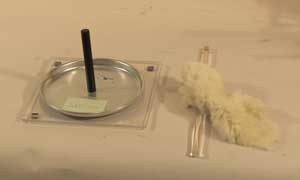Electrophorus, 5A10.20
Location:
Cabinet: Electricity and Magnetism Right
Bay: (A2)
Shelf: #1

Description:
Invented in 1764 by Johan Wilcke and was improved by Alessandro Volta 11 years later, the Electrophorus or Capacitive Generator produces an electrostatic charge from a process call induction. The Electrophorus is also called a "charge-bearer" and the electrical potential of an Electrophorus can be as high as 30 kV.
Equipment |
Location |
ID Number |
|
|
|
Electrophorus (Small) |
5A10.20.a |
|
Electrophorus (Large) |
5A10.20.b |
|
Rabbit Fur |
|
Setup:
- There is no setup procedure
Cautions, Warnings, or Safety Concerns:
- Our large Electrophorus can deliver a potential as high as 30 kV and can be an unpleasant shock but not too harmful.
Demonstration:
Small Electrophorus:
- Place flat acrylic plate on grounded conducting plane (not shown).??(Check)
- Rub the acrylic plate with the rabbit fur. This will negatively charge the acrylic plate.
- Place Electrophorus on plate
- Momentarily ground top surface of electrophorus to the same grounding plate that the acrylic plate is on.??(Check)
- Lift the electrophorus off the acrylic plate.
- Bring your finger to close to the electrophorus and a spark will jump.
- To repeat, start at step 3.
Large Electrophorus:
- Rub the glass plate with the rabbit fur. This will negatively charge the acrylic plate.
- Place Electrophorus on plate
- Momentarily ground top surface of electrophorus using the pice of alummum foil coming from the grounding plate benieth the electrophorus.
- Lift the electrophorus off the glass plate.
- Bring your finger to close to the electrophorus and a large spark will jump.
- To repeat, start at step 2.
attachment other photos |
attachment other photos |
attachment other photos |
attachment other photos |
References: